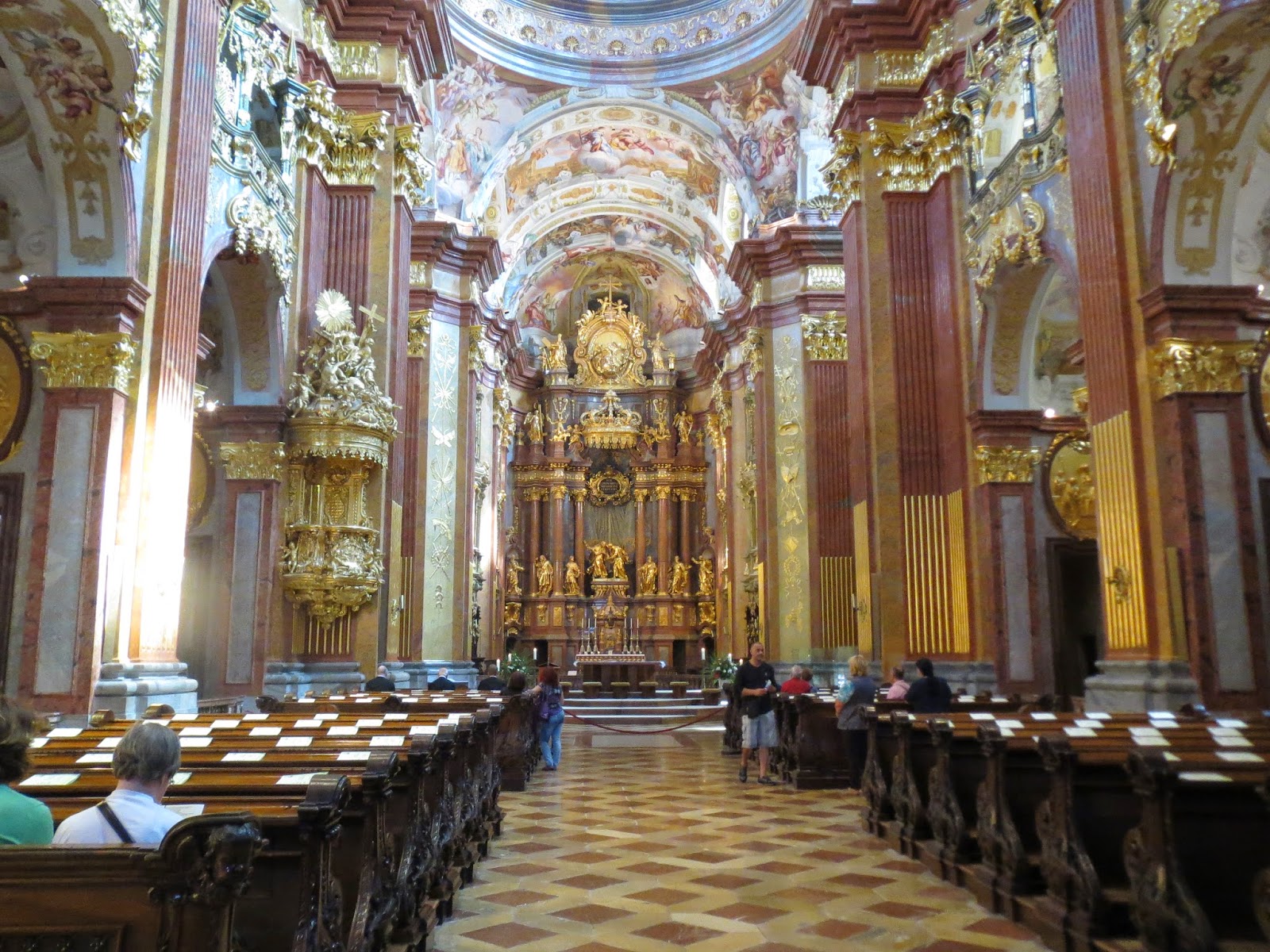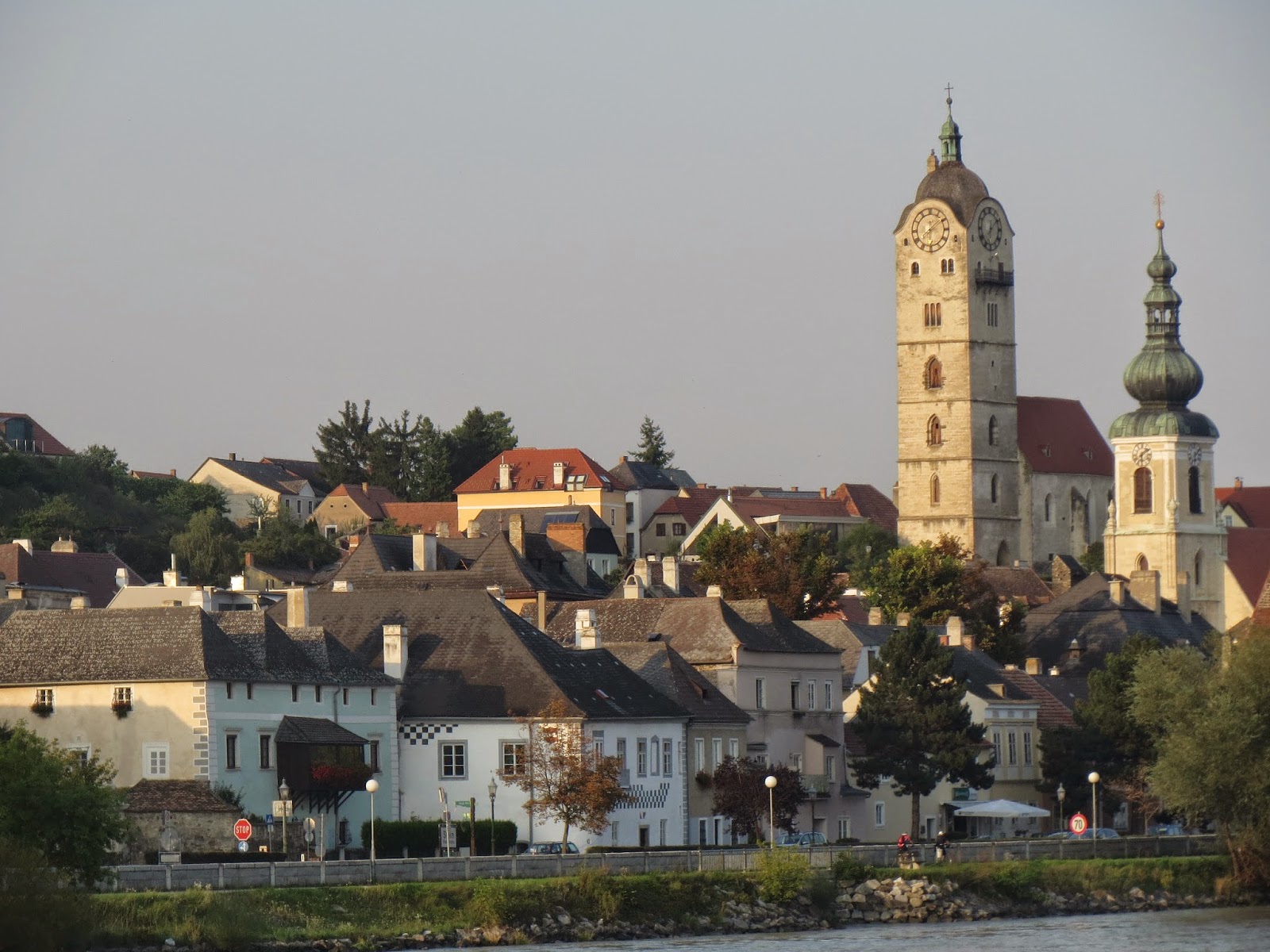Since we were staying for 6 nights in Vienna, we’d planned to take
several day trips: to nearby Melk to see its Benedictine abbey, to the lovely
wine growing town of Durnstein and also hoping to take a cruise on the Danube.
Imagine our surprise and delight when we were buying tickets just before the
train was leaving for Melk and we were asked if we’d like to combine all of the
above in just one day for only 49 Euro, about $70 for each of us! We hadn’t
known we could combine it all and thus weren’t prepared nor dressed for a 12 hour
day in all elements. It was raining for most of the train ride to Melk and we
both looked at each other and said ‘What are we getting ourselves into wearing
just shorts/ skort and t shirts?’ Too late to change our minds and of course this trip IS called an adventure so we were off come what may.
The town of Melk has been an important location in the Danube basin ever since the Romans built a
fortress over this tiny ‘branch’ of the Danube. The rock-strewn bluff where the abbey
now stands overlooking the river was the seat of the Babenburgs who ruled Austria from 976 until the Habsburgs took over.
In the 11th C., the abbey was presented to the Benedictine monks who
turned it into a fortified abbey. Melk was the centerof Austria in the 10th C., not Vienna. It’s still a working abbey so we were lucky
enough to see some monks going about their business.
We caught the 9am milk run train to Melk, located 55 miles west of Vienna, stopping at every station on the way. After arriving at 10:18, we walked directly to the nearby abbey and had enough time to walk around the Nord Bastien to see some exhibits and views from the terrace before our guided 1 hour tour of the Abby at 10:55.
 |
| Our 1st view of the abbey as we approached it from the train station. |
 |
| There are 7 courtyards in the monastery; the original one was built back in 529 and the towers date from the 10th C. |
 |
| On the Terrace with the Baroque Garden Pavilion in the background. |
 |
| Interesting exterior passageway, I thought. |
 |
Portraits of all Habsburgs' rulers down the very long hallway on the 2nd floor; the photo below is of the same hallway but facing a different direction.

There are currently only 30 monks in the 497 room abbey; the oldest one is 94; 72% of Austrians are Catholic and many are Lutheran. Since the 12th C., the monks have operated a school on the grounds of the abbey. There are 900 students now, many of whom take the train daily from up to an hour away to attend the school; girls were admitted in 1960.
|
 |
| Our tour included seeing the Melk Abbey's astounding Museum. There are normally 500,000 tourists a year visiting the abbey. |
 |
| The oldest manuscript of the Rules of the Monastery; there were 72 chapters of rules written down for Benedictine monks to follow but they can be summarized as Work, Prayer and Study. In the Monastery's Library there are 85,000 books! |
 |
| Statue of St. Benedict |
 |
| The Melk Cross from 1362 made of silver, goldplate, enamel, precious gems, Roman cameo, and pearls. It's the most precious treasure and holiest relic in the monastery. |
 |
| Joseph II was famous for building schools and hospitals including the 1st one for the mentally ill; he also came up with the idea of a coffin that would open from below releasing the body directly into the grave (see above). As the guide joked, "It was a little early for recycling." |
 |
| More of the winged altarpieces I love. |
 |
| The so called 'Marble Hall' but only the arches in the door frames are actually marble; the rest is just stucco; it's used a dining room. |
 |
| Not sure if you noticed the open windows above the door in the 1st photo of the room above? They lead to a room where the orchestra played while dinner was served. |
 |
| These are NOT totally naked, JK!! |
 |
| View of Melk from the Abbey terrace. |
 |
Napoleon is thought to have used the view of the river from the abbey terrace when he made Melk his headquarters during the campaign against Austria! This was our 1st view of the famous Danube we'd read so much about.
 |
| Our 1st view of the magnificent abbey church. |
Despite all the adornments in the abbey, it is still surpassed in
lavish glory by the Stiftskirche, the golden abbey church. We toured it by ourselves but rather quickly so we could also see the adjacent Melk Abbey Park before having to be at the 'Ship Station' for our cruise up the Danube.
|
 |
| Doesn't the map look like the gardens surrounding the abbey would be huge? We'd thought so too but twas not the case at all; we saw them all, albeit quicker than we'd liked becauseof having to get to the boat, in about 20 minutes. |
 |
| The path was closed because the linden trees are more than 250 years old, and thus there's a high risk of falling branches. |
 |
| The Kissing Monkeys! |
 |
The 'Talking Stones;' there were about 10 of these differently shaped stones and each one 'talked' to us as we passed it. Didn't understand any of it though as it was all in German though.
Cruising the Danube: Then,
walked down to the ‘Ship Station’ to take an amazing 2 hour cruise on the Danube to Durnstein. The Danube, or Donau as it’s known in German, is the
quintessential European river of so many nations and people all encountering
each other. Tour guides say the Danube, cynics aside, is really blue at least
on sunny days. It was indeed gloriously sunny but we didn’t notice the river
being blue! How fortunate we were being on one of the world’s most famous and
scenic rivers at all, let alone in great weather when we hadn’t dressed for
time in an open boat on the river. Riding bikes along the Danube must be a very popular pastime as there
were lots of cyclists getting on and off the boat at every stop. I love bike
riding but I don’t fancy carrying all my gear in saddlebags on a bike for a
‘fun time’!
|

 |
|

 |
| View of another monastery high atop a nearby hill. |
More views of the Danube; hey we were excited!
 |
| Darlene: thank goodness I still had the last granola bar of yours to munch on as it came in very handy right then! |
 |
| The Hinterhaus Ruins |
 |
| The areas around the towns of Melk and Durnstein is known as the 'Wachau' or wine growing area; you can see why here. We passed terraced vineyards like these on both sides of the river for a long time. |
 |
| How beautiful and picturesque even on a hazy day. |
Spectacular sights all along the Danube: the Gottweig Benedictine Monastery, the town of Spitz above, a picturesque wine-growing town; the impressive remains of a fortress consisting of 3 parts on a rocky ridge on a local hill; Fort Aggstein ruins dating back to the 12th C; and yet more castles and abbeys.
 |
Durnstein,
50 miles west of Vienna, is the loveliest town in the beautiful Wachau, or wine area, and
accordingly draws throngs of visitors in the summer. We had fun walking through
town on the main street, Hauptstrasse, which is flanked by richly adorned
ancient homes, many dating from the 1500’s.
|
 |
| This was our 2nd stop of the day. |
 |
Get a sense of how above the Danube the Durnsein castle ruins are? Well, we climbed to the top.
|
We climbed to the top of the ruins of the Durnstein Castle
for some breathtaking views of the Danube far below. The sight was marred unfortunately by a drone, if you
please, hovering closely above for most of the time we were there. First time
I’d seen one and I’m sure there’s a time and place for them but NOT on such a
perfectly idyllic spot in my opinion. King Richard the Lionheart of England was
imprisoned in the castle and later freed with the help of his loyal mistress,
Blondel!
 |
| Views of the Danube climbing to the ruins. |
 |
| Can't remember seeing a Robin Hood sign before outside of the UK that is. |
 |
Burgruine in 20 minutes; i.e. to the castle ruins.
Do you remember seeng the photos of the blue church as we arrived in Durntein? We stopped in at the 15th C. Pfarrkirche (Parish Church) next; it was originally an Augustinian
monastery and was reconstructed when the Baroque style swept Austria. The striking blue church steeple and tower
is a prominent landmark in the Danube Valley as it can be seen from so far away.
|
 |
| I believe a boy was being confirmed while we were there. Fascinating seeing the family and friends all dressed in native Austrian attire for such an important occasion. |
 |
| The Donation box was actually a wine barrel as befitting the Wachau, certainly a first for us! |
 |
| Sign showing us direction of 10 plaques and 'monuments' of different characters up one of the side streets. |
 |
Robin Hood rises again.
|
 |
| Enjoyed reading the plaques from the 1st person perspective. Sorry my shadow is also in it! |
 |
| Walking down to the boat to catch it to Krems, our final destination for the day. |
 |
| Wonderful relaxing back on the boat for the 20 minute cruise on to the 1,000 year old city of Krems. We only had enough time there though for a quick walk to catch the 17:50 train back to Vienna. |
What an absolutely lovely day especially since we had no idea what lay in store for us when leaving the hostel.


















































































No comments:
Post a Comment